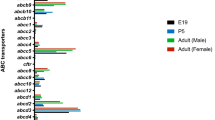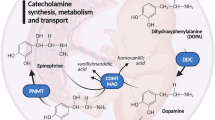Abstract
1. In utero exposure to poisons and drugs (e.g., anticholinesterases, cocaine) is frequently associated with spontaneous abortion and placental malfunction. The major protein interacting with these compounds is butyrylcholinesterase (BuChE), which attenuates the effects of such xenobiotics by their hydrolysis or sequestration. Therefore, we studied BuChE expression during placental development.
2. RT-PCR revealed both BuChEmRNA and acetylcholinesterase (AChE) mRNA throughout gestation. However, cytochemical staining detected primarily BuChE activity in first-trimester placenta but AChE activity in term placenta.
3. As the atypical variant of BuChE has a narrower specificity for substrates and inhibitors than the normal enzyme, we investigated its interactions with α-solanine and cocaine, and sought a correlation between the occurrence of this variant and placental malfunction.
4. Atypical BuChE of serum or recombinant origin presented >10-fold weaker affinities than normal BuChE for cocaine and α-solanine. However, BuChE in the serum of a heterozygote and a homozygous normal were similar in their drug affinities. Therefore, heterozygous serum or placenta can protect the fetus from drug or poison exposure, unlike homozygous atypical serum or placenta.
5. Genotype analyses revealed that heterozygous carriers of atypical BuChE were threefold less frequent among 49 patients with placental malfunction than among 76 controls or the entire Israeli population. These observations exclude heterozygote carriers of atypical BuChE from being at high risk for placental malfunction under exposure to anticholinesterases.
Similar content being viewed by others
REFERENCES
Balasubramanian, A. S. (1984). Have cholinesterases more than one function? Trends Neurosci. 9:467–468.
Booth, A. G., Olaniyan, R. O., and Vanderpuye, O. A. (1980). An improved method for the preparation of human placental syncytiotrophoblast. Placenta 1:327–336.
Chasnoff, I. J., Burns, W. J., Schnoll, S. H., and Burns, K. A. (1985). Cocaine use in pregnancy. N. Engl. J. Med. 313:666–669.
Chatonnet, A., and Lockridge, O. (1989). Comparison of butyrylcholinesterase and acetylcholinesterase. Biochem. J. 260:625–634.
de-Cock, J., Westveer, K., Heederik, D., Te-Velde, E., and Van-Kooij, R. (1994). Time to pregnancy and occupational exposure to pesticides in fruit growers in The Netherlands. Occup. Environ. Med. 51:693–699.
Ehrlich, G., Ginzberg, D., Loewenstein, Y., Glick, D., Kerem, B., Ben-Ari, S., Zakut, H., and Soreq, H. (1994). Population diversity and distinct haplotype frequencies associated with ACHE and BCHE genes of Israeli Jews from trans-Caucasian Georgia and from Europe. Genomics 22:288–295.
Gatley, S. J. (1991). Activities of the enantiomers of cocaine and some related compounds as substrates and inhibitors of plasma butyrylcholinesterase. Biochem. Pharmacol. 41:1249–1254.
Guller, S., Gravanis, A., and Gurpide, E. (1986). Steroid metabolizing enzymes associated with the microvillar membrane of human placenta. J. Steroid Biochem. 24:935–944.
Hahn, T., Desoye, G., Land, I., and Skofitsch, G. (1993). Location and activities of acetylcholinesterase and butyrylcholinesterase in the rat and human placenta. Anat. Embryol. 188:435–440.
Jbilo, O., Bartels, C. F., Chatonnet, A., Toutant, J.-P., and Lockridge, O. (1994). Tissue distribution of human acetylcholinesterase and butyrylcholinesterase messenger RNA. Toxicon 32:1445–1457.
Jeong, T. C., Jordan, S. D., Matulka, R. A., Stanulis, E. D., Kamiski, E. J., and Holsapple, M. P. (1995). Role of metabolism by esterase and cytochrome P-450 in cocasine-induced suppression of the antibody response. J. Pharmacol. Exp. Ther. 272:407–416.
Jones, C. J. P., and Fox, H. (1991). Ultrastructure of the normal human placenta. Electron Microsc. Rev. 4:129–178.
Karnovsky, M. J., and Roots, L. (1964). A direct coloring thiocholine method for cholinesterases. J. Histochem. Cytochem. 12:219–221.
Karpel, R., Ben Aziz-Aloya, R., Sternfeld, M., Ehrlich, G., Ginzberg, D., Tarroni, P., Clementi, F., Zakut, H., and Soreq, H. (1994). Expression of three alternative acetylcholinesterase messenger RNAs in human tumor cell lines of different tissue origins. Exp. Cell Res. 210:268–277.
Khalfoun, B., Lacord-Bonneau, M., Degenne, D., Clement, L., and Bardos, P. (1986). Characterization of the human syncytiotrophoblast plasma membrane associated components. Int. J. Biochem. 18:351–360.
Layer, L. G., and Willbold, E. (1995). Novel functions of cholinesterases in development, physiology and disease. Prog. Histochem. Cytochem. 29:1–93.
LeDuc, B. W., Sinclair, P. R., Walton, H. S., Sinclair, J. R., Greenblatt, D. J., and Schuster, L. (1994). Cocaine toxicity in cultured chicken hepatocytes: Role of cytochrome P-450. Toxicol. Appl. Pharmacol. 125:322–332.
Lev-Lehman, E., Ginzberg, D., Hornreich, G., Ehrlich, G., Meshorer, A., Eckstein, F., Soreq, H., and Zakut, H. (1994). Antisense inhibition of acetylcholinesterase gene expression causes transient hematopoietic alterations in vivo. Gene Ther. 1:127–135.
Levene, C., Steinberg, A. G., Friedlander, Y., Brautbar, C., and Cohen, T. (1984). Genetic polymorphisms among Bukharan and Georgian Jews in Israel. Am. J. Med. Genet. 19:623–641.
Liao, J., Mortensen, V., Norgaard-Pedersen, B., Koch, C., and Brodbeck, U. (1993). Monoclonal antibodies against brain acetylcholinesterase which recognize the subunits bearing the hydrophobic anchor. Eur. J. Biochem. 215:333–340.
Lockridge, O. (1990). Genetic variants of serum cholinesterase influence metabolism of the muscle relaxant succinylcholine. Pharmacol. Ther. 47:35–60.
Lockridge, O., Bartels, C. F., Zelinski, T., Jbilo, O., and Kris, M. (1992). Part 1: Genetic variant of human acetylcholinesterase. 2. SV-40 transformed cell lines, for example COS-1, but not parental untransformed cell lines, express butyrylcholinesterase (BCHE). In Multidisciplinary Approaches to Cholinesterase Functions (A. Shafferman and B. Velan, Eds.), Plenum Press, New York, pp. 53–59.
Loewenstein, Y., Denarie, M., Zakut, H., and Soreq, H. (1993). Molecular dissection of the cholinesterase domains responsible for carbamate toxicity. Chem.-Biol. Interact. 87:209–216.
Loewenstein-Lichtenstein, Y., Schwarz, M., Glick, D., Norgaard-Pedersen, B., Zakut, H., and Soreq, H. (1995). Predisposition to adverse consequences of anti-cholinesterase therapies in “atypical” BCHE carriers. Nature Med. 1:1082–1085.
MacGregor, S. N., Keith, L. G., Chasnoff, I. J., Rosner, M. A., Chisum, G. M., Slaw, P., and Minogue, J. P. (1987). Cocaine use during pregnancy: Adverse prenatal outcome. Am. J. Obstet. Gynecol. 157:686–690.
Massoulié, J., Pezzementi, L., Bon, S., Krejci, E., and Vallette, J. M. (1993). Molecular and cellular biology of the cholinesterases. Prog. Neurobiol. 41:31–91.
May, D. G. (1994). Genetic differences in drug disposition. J. Clin. Pharmacol. 34:881–897.
McGuire, M. C., Noguiera, C. P., Bartels, C. F., Lightsone, H., Hajara, A., van der Spek, A. F. L., Lockridge, O., and La Du, B. N. (1989). Identification of the structural mutation responsible for the dibucaine-resistant (atypical) variant form of human serum cholinesterase. Proc. Natl. Acad. Sci. USA 86:953–957.
Neville, L. F., Gnatt, A., Padan, R., Seidman, S., and Soreq, H. (1990). Anionic site interactions in human butyrylcholinesterase disrupted by two adjacent single point mutations. J. Biol. Chem. 265:20735–20738.
Neville, L. F., Gnatt, A., Loewenstein, Y., Seidman, S., Ehrlich, G., and Soreq, H. (1992). Intramolecular relationships in cholinesterases revealed by oocyte expression of site-directed and natural variants of human BCHE. EMBO J. 11:1641–1649.
Peretti, F. J., Isenchmid, D. S., Levine, B., Caplan, Y. H., and Smialek, J. E. (1990). Cocaine fatality: An unexplained blood concentration in a fatal overdose. Forens. Sci. Int. 48:135–138.
Prody, C. A., Zevin-Sonkin, D., Gnatt, A., Goldberg, O., and Soreq, H. (1987). Isolation and characterization of full-length cDNA clones coding for cholinesterase from fetal human tissues. Proc. Natl. Acad. Sci. USA 84:3555–3559.
Rachmilewitz, J., Elkin, M., Rosensaft, J., Gelman-Kohan, Z., Ariel, I., Lustig, O., Schneider, T., Goshen, R., Biran, H., de Groot, N., and Hochberg, A. (1995). H19 expression and tumorigenicity of choriocarcinoma derived cell lines. Oncogene 11:863–870.
Rakonczay, Z., and Brimijoin, S. (1988). Biochemistry and pathophysiology of the molecular forms of cholinesterases. In Subcellular Biochemistry (J. Harris, Ed.), Plenum, New York, Vol. 12, pp. 335–378.
Rama Sastry, B. V., and Sadovinguad, C. (1979). Cholinergic systems in non-nervous tissues. Pharmacol. Rev. 30:65–132.
Ratner, D., Oren, B., and Vigder, K. (1983). Chronic dietary anticholinesterase poisoning. Isr. J. Med. Sci. 19:810–814.
Roe, D. A., Little, B. B., Bawdon, R. E., and Gilstrup, L. C. (1990). Metabolism of cocaine by human placentas: Implications for fetal exposure. Am. J. Obstet. Gynecol. 163:715–718.
Schwarz, M., Glick, D., Loewenstein, Y., and Soreq, H. (1995a). Engineering of human cholinesterases explains and predicts diverse consequences of administration of various drugs and poisons. Pharmacol. Ther. 67:283–332.
Schwarz, M., Loewenstein-Lichtenstein, Y., Liao, J., Norgaard-Pedersen, B., and Soreq, H. (1995b). Successive organophosphate inhibition and oxime reactivation reveals distinct responses of recombinant human cholinesterase variants. Mol. Brain Res. 31:101–110.
Seidman, S., Sternfeld, M., Ben Aziz-Aloya, R., Timberg, R., Kaufer-Nachum, D., and Soreq, H. (1995). Synaptic and epidermal accumulation of human acetylcholinesterase is encoded by alternative 3′-terminal exons. Mol. Cell Biol. 14:459–473.
Sherman, J. D. (1997). Chlorphyrifos (dursban) associated birth defects report of four cases. Arch. Environ. Health Int. J. 51 (in press).
Simone, C., Derewlany, L. O., Oskamp, M., Johnson, D., Knie, B., and Koren, G. (1994). Acetylcholinesterase and butyrylcholinesterase activity in the human term placenta: Implications for fetal cocaine exposure. J. Lab. Clin. Med. 123:400–406.
Soreq, H., and Zakut, H. (1993). Human Cholinesterases and Anticholinesterases, Academic Press, San Diego, CA.
Soreq, H., Ben-Aziz, R., Prody, C. A., Gnatt, A., Neville, L., Lieman-Hurwitz, J., Lev-Lehman, E., Ginzberg, D., Seidman, S., Lapidot-Lifson, Y., and Zakut, H. (1990). Molecular cloning and construction of the coding region for human acetylcholinesterase reveals a G, C-rich attenuating structure. Proc. Natl. Acad. Sci. USA 87:9688–9692.
Szeinberg, A., Pipano, S., Assa, M., Medalie, J. H., and Neufeld, H. N. (1992). High frequency of atypical pseudocholinesterase among Iraqi and Iranian Jews. Clin. Genet. 3:123–127.
Tabacova, S., and Balabaeva, L. (1993). Environmental pollutants in relation to complications of pregnancy. Environ. Health Perspect. 101:27–31.
Valentino, R. J., Lockridge, O., Eckerson, H. W., and La Du, B. N. (1981). Prediction of drug sensitivity in individuals with atypical serum cholinesterase based on in vitro biochemical studies. Biochem. Pharmacol. 30:1643–1649.
Volpe, J. J. (1992). Effect of cocaine use on the fetus. N. Engl. J. Med. 327:399–406.
Whittaker, M. (1986). Cholinesterases, Karger, Basel.
Whyte, A. (1983). Biochemistry of the human syncytiotrophoblast plasma membrane. In Biology of Trophoblast (Y. W. Loke and A. Whyte, Eds.), Elsevier Science BV, Amsterdam, pp. 513–533.
Wu, D., and Hersh, L. B. (1994). Choline acetyltransferase: Celebrating its fiftieth year. J. Neurochem. 62:1653–1663.
Zakut, H., Lieman-Hurwitz, J., Zamir, R., Sindell, L., Ginzberg, D., and Soreq, H. (1991). Chorionic villi cDNA library displays expression of butyrylcholinesterase: Putative genetic disposition for ecological danger. Prenat. Diag. 11:597–607.
Author information
Authors and Affiliations
Rights and permissions
About this article
Cite this article
Sternfeld, M., Rachmilewitz, J., Loewenstein-Lichtenstein, Y. et al. Normal and Atypical Butyrylcholinesterases in Placental Development, Function, and Malfunction. Cell Mol Neurobiol 17, 315–332 (1997). https://doi.org/10.1023/A:1026394302076
Issue Date:
DOI: https://doi.org/10.1023/A:1026394302076




